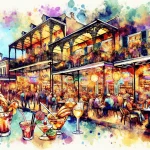The Beauregard-Keyes House, situated in the French Quarter of New Orleans, offers a captivating glimpse into the city’s rich cultural tapestry. Constructed in 1826, this National Historic Landmark has been home to prominent figures like Confederate General P.G.T. Beauregard and acclaimed author Frances Parkinson Keyes, who played a pivotal role in its restoration.
In This Article
TL;DR
- The house exemplifies the unique architectural fusion of Creole and American styles prevalent in 19th-century New Orleans homes.
- Influential residents like General Beauregard and Frances Parkinson Keyes have left an indelible mark on the property’s history and preservation.
- As a museum and cultural center, the house contributes to New Orleans‘ rich heritage by hosting events, educational programs, and preserving the city’s architectural and cultural legacy.
Historical Overview
Constructed in 1826 for wealthy auctioneer Joseph LeCarpentier, designed by architect François Correjolles and built by James Lambert, the Beauregard-Keyes House featured an adjoining parterre garden added in the 1830s by the Merle family, subsequent owners. In 1865, Confederate General P.G.T. Beauregard rented the home upon his return from the Civil War, leaving an enduring mark. Decades later, in 1944, renowned author Frances Parkinson Keyes discovered the house and initiated a meticulous restoration, furnishing it with period pieces and establishing the Keyes Foundation to maintain the property as a museum.
Architectural Significance
Raised Cottage Style
An exceptional example of the raised cottage style, the Beauregard-Keyes House combines traditional Creole architecture with Greek Revival elements. The symmetrical façade, adorned with columns and a pale yellow exterior, exemplifies the classical influence on New Orleans’ residential architecture.
Interior Features
Inside, hardwood floors, intricate classical moldings, and a layout featuring a large parlor, ballroom, rectangular dining room, and a porch characterize the house. The rear elevation mirrors the front, with a wraparound porch supported by columns overlooking the parterre garden. The preservation efforts of architects like General Allison Owen and Sam Wilson have ensured the house’s historical integrity.
The House as a Cultural Hub
Under Frances Parkinson Keyes’ ownership, the Beauregard-Keyes House became a focal point for literary and cultural pursuits. Keyes penned numerous works while residing here, including “Madame Castel’s Lodger,” which fictionalized General Beauregard’s life, and “The Chess Players,” inspired by the original owner’s grandson.
Its transformation into a museum has solidified the house’s role as an educational resource, offering visitors a glimpse into New Orleans’ past. The Beauregard-Keyes House also hosts cultural events, contributing to the city’s vibrant arts and heritage scene.
Exploring the Beauregard-Keyes House
When planning a visit, consider the guided tours available Wednesday through Saturday, 10 am to 3 pm. These tours highlight key rooms, period furniture, and art collections that bring the house’s history to life. Don’t miss the opportunity to stroll through the historic parterre garden, added by the Merle family in the 1830s.
Admission is $15 for adults, $13 for seniors and students, and $8 for children ages 6-12. The house is closed on major holidays.
Preservation Efforts and Community Engagement
The Keyes Foundation, established by Frances Parkinson Keyes, has been instrumental in preserving the Beauregard-Keyes House and ensuring public access. Volunteers and community members play a vital role in maintaining the house and garden, while educational programs and partnerships with local institutions foster a deeper appreciation for New Orleans’ history.
The Beauregard-Keyes House Today
As a museum, event space, and cultural center, the Beauregard-Keyes House continues to contribute to New Orleans’ tourism and local economy. Future plans include expanding educational offerings and encouraging public involvement in preservation efforts.
Visitors can support the Beauregard-Keyes House by becoming members of the Keyes Foundation, volunteering, or attending the various cultural events hosted throughout the year.






